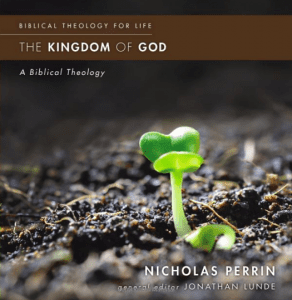 Jesus can only be comprehended as someone in a story that is resolved by who he is and what he accomplished. But which story? Nicholas Perrin asks this question in The Kingdom of God: A Biblical Theology.
Jesus can only be comprehended as someone in a story that is resolved by who he is and what he accomplished. But which story? Nicholas Perrin asks this question in The Kingdom of God: A Biblical Theology.
It’s too easy to impose our own stories on what Jesus accomplished — whether it is a story of human dignity or progressivism or liberalism or conservatism or Calvinism or Anabaptism or whatever… Perrin offers a sound approach to the story inside the story about Jesus:
When Jesus appeared, preaching the good news of the kingdom, he was providing his own answer to this question. In fact, it was an answer that was in many respects like the story shared across Judaism. In the distant past, Israel had hopes of occupying the land, keeping the law, and sitting under the leadership of David’s seed line. But then Israel had squandered its elective privileges, broken its covenant with Yahweh, and been forced as captives into exile. Eventually Yahweh brought Israel out of geographical exile, but this only presaged the still-future moment when the eschatological promises of the prophets would be more fully cashed out. Especially with ten of Israel’s tribes still unaccounted for, there was far too much still wrong with the status quo during the postexilic era to suppose that return from exile had completely taken place. Return from exile still remained at the top of Israel’s agenda. In all these respects, the story lines touted by Jesus and first-century Judaism matched.
But here comes the twister: for the early Christians, the climax of redemptive history had arrived in the person of Jesus Christ. Until Jesus’s return, in this “in between time” before the close of history, it fell to Jesus’s followers to preach him as Israel’s Messiah and risen Lord. In these respects, the early Christians had their own distinctive answer to the “What happened?” question, which in turn illuminates their answer to our “what” question. By following the story line of Israel, from Abraham down to the Second Temple period, we will be a big step closer to answering both questions, but most importantly, “What is the kingdom of God?’
One’s biblical hermeneutic comes into play and the most common hermeneutic goes covenant and explains everything through the lens of covenant theology. The problem with covenant is how little Jesus actually uses the term. He did not “think” with that term; he thought with “kingdom.” So it is really encouraging to see Perrin work covenant into kingdom and kingdom into covenant. Cleverly, he begins with Matthew’s geneaology:
Conversely, for anyone who already knows the story (i.e., most first-century readers), a rehearsal of a who’s who in redemptive history—such as we have in Matthew 1—would bring to mind the redemptive plotline. As the evangelist parses it, it is a plotline made up of three acts or three eras: from Abraham to David (w. 2-6a), from David to the exile (w. 6b—11), and from the exile to the Christ (vv. 12-16). In his concluding remark, Matthew notes that each of the three eras is marked off by fourteen generations (v. 17). Whatever the meaning of the number fourteen (and there are several good explanations here), if Matthew partitioned redemptive history in this way in preparation for his story of Jesus and the kingdom, we might be off to a good start if we follow suit.
He examines a number of major plotline developments. He focuses on Abraham, adds Moses to Matthew’s own narrative plotline, then moves to David — and does a good job using the theme of exile. Here is Perrin’s summary:
In the Abrahamic covenant, the promise of the seed entailed the prospect of sacred space, providing a beachhead in opposition to the kingdoms of this world (Babel), thereby holding out promise for a restored humanity;
In the Mosaic covenant, Israel is established as a “kingdom of priests” (Ex. 19:6), a kingdom which, having been initiated through suffering, retained the potential for ruling the nations of creation (Deut. 28:1-10), but only as they imaged God through keeping his covenant;
In the Davidic covenant, the full flowering of the kingdom now becomes closely aligned with the royal and priestly figure of David, the Son of God, whose rule would ideally embody the righteousness and justice appropriate to the image of God;
Because the kingdom purposes have been frustrated by idolatry, Yahweh removes the wall of protection separating his people from gentile incursions and exile ensues;
The prophets envision the restoration of the kingdom taking place through a Davidic figure and/or Adamic figure, but only through suffering.












